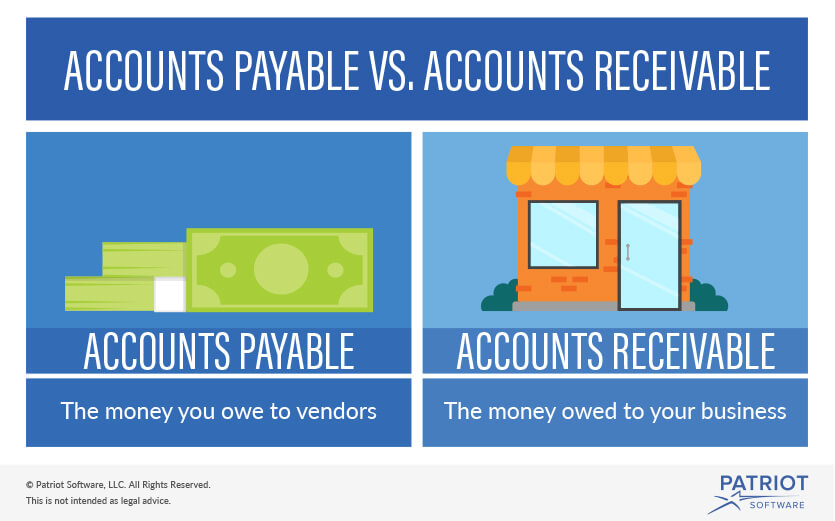As a small business owner, setting up your accounting books and maintaining accurate records is essential. To make that happen, you need to be familiar with accounts payable and accounts receivable. Both accounting entries are part of double-entry bookkeeping, but what is the difference between accounts payable vs. accounts receivable?
What is the difference between accounts payable and accounts receivable?
Accounts payable and accounts receivable are general ledger entries you record if you use accrual accounting. Both accounts are recorded when revenues and expenses are incurred, not when cash is exchanged. Create an accounts receivable entry when you offer credit to your customers. Make an accounts payable entry when you purchase something on credit.
Since accounts payable and accounts receivable require double-entry bookkeeping, you will need to create debits and credits for each account. That helps you balance your books.
So what exactly is the difference between accounts payable and accounts receivable?
Accounts payable
Accounts payable (AP, payables) is the money you owe to vendors. A payable is a liability because you still need to pay it.
If you purchase a good or service on credit, you receive an invoice from your vendor. The invoice tells you how much money you owe, or your accounts payable. And, the invoice tells whom you owe money to as well as the due date. Since invoices typically require payments within a short period of time, payables are current (short-term) liabilities.
To keep track of the liability, record the amount as a payable in your accounting books. Liabilities are increased by credits and decreased by debits.
When you receive an invoice, the amount of money you owe increases (accounts payable). Since liabilities are increased by credits, you will credit the accounts payable. And, you need to offset the entry by debiting another account.
When you pay off the invoice, the amount of money you owe decreases (accounts payable). Since liabilities are decreased by debits, you will debit the accounts payable. And, you need to credit your cash account to show a decrease in assets.
Accounts payable example
Take a look at how accounts payable entries work. Here’s how your small business ledger would look when you purchase inventory.
| Date | Account | Notes | Debit | Credit |
| X/XX/XXXX | Inventory | Money owed to ABC Company for supplies | 1,500 | |
| Accounts Payable | 1,500 |
Now, here is how your accounts payable entry would look when you pay off the debt.
| Date | Account | Notes | Debit | Credit |
| X/XX/XXXX | Accounts Payable | Payment to ABC Company for supplies | 1,500 | |
| Cash | 1,500 |
Accounts receivable
Accounts receivable is the money owed to your business. It is an asset because it is money you will receive.
If you extend credit to customers, you will have accounts receivables. When you sell a good or service but do not collect immediate payment, you still need to record the transaction. Since you expect to receive payment in the immediate future, accounts receivable are current assets.
To keep track of the asset, record the amount as a receivable in your accounting books. Assets are increased by debits and decreased by credits.
When you sell an item to a customer without receiving money, the amount owed to you increases. That means you must debit your accounts receivable. And, you will need to credit another account, like inventory, to show you have a decrease in goods.
When a customer pays you, the amount of money owed to you decreases, so you will credit your accounts receivable. And, you will debit your cash account since you have more money.
Accounts receivable example
When you make a sale but do not collect payment, you need to make an entry that shows how much money is owed to you. Here is how your ledger would look.
| Date | Account | Notes | Debit | Credit |
| X/XX/XXXX | Accounts Receivable | Money XYZ Company owes you for supplies | 1,500 | |
| Inventory | 1,500 |
Now, take a look at how your entries would look when you receive payment. You need to create new entries that reflect your increase in cash and decrease in money owed to you.
| Date | Account | Notes | Debit | Credit |
| X/XX/XXXX | Cash | XYZ Company payment | 1,500 | |
| Accounts Receivable | 1,500 |
What do you do when customers don’t pay?
As frustrating as it might be, you may not receive payments from customers. You will need to create your second entry a little differently than when you receive payments.
You need to reverse your receivable since you are not going to get paid. Money not paid to you is known as a bad debt. A bad debt expense is a non-cash expense account that shows your loss. You will need to debit your expense account because expenses increase with debits. And, you will credit your accounts receivable account to show you no longer expect a payment.
If you experience a bad debt, your second entry will look like this:
| Date | Account | Notes | Debit | Credit |
| X/XX/XXXX | Bad Debt Expense | Lack of XYZ Company payment | 1,500 | |
| Accounts Receivable | 1,500 |
You will still decrease your accounts receivable, but you won’t gain cash. Instead, you will increase your bad debts expense. In some cases, you might be able to reduce your tax liability when you write off bad debt.
Accounts payable vs. accounts receivable
To recap, you need to know the difference between accounts payable and accounts receivable entries.
Accounts payable is:
- Money you owe to vendors
- A liability
- Increased by a credit and decreased by a debit
Accounts receivable is:
- Money owed to you
- An asset
- Increased by a debit and decreased by a credit
Creating accounts receivable and accounts payable entries updates your accounting books and keeps track of your incoming and outgoing money.
Tracking your small business’s transactions shouldn’t be a hassle. Patriot’s online accounting software makes it easy to record incoming and outgoing money. Created for non-accountants, our software lets you get back to doing what you love. Try it for free today!
This is not intended as legal advice; for more information, please click here.
